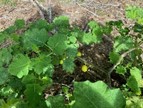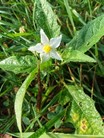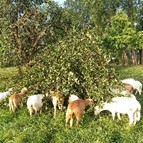Like many sheep articles, personal experience was the inspiration for this one. And like most sheep problems, the exact cause isn’t certain, but the pattern of symptoms – photosensitivity and the sudden death of a few 7-month-old ram lambs – led to a suspected diagnosis of plant toxicity and photosensitivity  exacerbated by a brutally hot summer.
exacerbated by a brutally hot summer.
Photosensitization is an inflammation of the skin and is caused by either primary sources (e.g., direct contact with photosensitizing plants) or secondary causes from liver damage caused by an accumulation of toxins. Primary plant toxicity is the most common cause in sheep and occurs either by direct skin contact or by ingestion. White sheep and those with pink skin around the eyes and mouth are more susceptible to the photosensitizing effects of toxic plants. Areas of the body with less hair cover are most often affected: muzzle, ears, eyes, udder, vulva, under the tail and even the soft tissue around the hooves.
The few cases of photosensitization I’ve seen in the past were isolated. I might find a lamb hiding out in the deep shade looking pitiful. Usually, the ears would be swollen and hanging down and the lamb would have mild edema or patches of hair loss on the face often exposing red and weepy underlying tissue, particularly around the eyes, nose and lips. All eventually recovered over time.
But this year was different. While doing chores one evening I found a dead lamb with no outward signs of illness or inflammation. He appeared perfectly healthy the day before. The other lambs all appeared to be acting normally, but when I looked closely, I noticed that about a third had facial lesions (hair loss with inflamed skin similar to a severe sunburn). The others appeared unaffected. Interestingly, the lambs that developed facial lesions were all white. Within a few days, two more of the “unaffected” lambs died. After  consulting two veterinarians, plant toxicity/photosensitivity was felt to be the most likely cause. A thorough search of the paddock the lambs were grazing in turned up two species of nightshade, one known to be especially toxic to livestock when ingested.
consulting two veterinarians, plant toxicity/photosensitivity was felt to be the most likely cause. A thorough search of the paddock the lambs were grazing in turned up two species of nightshade, one known to be especially toxic to livestock when ingested.
 If a sheep has direct contact with a photosensitizing plant while grazing, the toxin gets absorbed through the skin and into the underlying capillaries. When ingested, higher levels of the toxin are circulated throughout the bloodstream as well as the liver. In either case, once it reaches the superficial capillaries of the skin and eyes, sunlight activates the toxin causing local irritation and skin damage. The damage to the skin can be either relatively mild or more severe causing the skin to slough off. If the animal ingests a lot of the leaves or worse, the fruit of these plants, liver toxicity can lead to sudden death. If the liver is damaged, jaundice (yellow discoloration) of the skin, gums and the whites of the eyes may occur.
If a sheep has direct contact with a photosensitizing plant while grazing, the toxin gets absorbed through the skin and into the underlying capillaries. When ingested, higher levels of the toxin are circulated throughout the bloodstream as well as the liver. In either case, once it reaches the superficial capillaries of the skin and eyes, sunlight activates the toxin causing local irritation and skin damage. The damage to the skin can be either relatively mild or more severe causing the skin to slough off. If the animal ingests a lot of the leaves or worse, the fruit of these plants, liver toxicity can lead to sudden death. If the liver is damaged, jaundice (yellow discoloration) of the skin, gums and the whites of the eyes may occur.
An animal with suspected photosensitivity should be immediately housed or penned in full shade for at least a week or more. Consult your veterinarian for treatment with antibiotics to prevent secondary infection. Steroids are often prescribed to treat inflammation. If the eyes are affected, an ophthalmic antibiotic may be prescribed. Keep the pen clean to avoid flystrike which could cause further complications and delay healing. Mild or superficial cases can resolve in 6-7 days while more severe cases could last 3-4 weeks.
There are several plant species that cause photosensitivity. Most are weeds that can be choked out by planting cover crops or by improving your pastures. Some of the more common culprits include St. John’s wort, buckwheat, bishop’s weed, nightshade species (nettles), spring parsley, and some species of  clover, alfalfa, and brassicas (e.g., rape scald). And unfortunately, there are many unknown causes of photosensitization.
clover, alfalfa, and brassicas (e.g., rape scald). And unfortunately, there are many unknown causes of photosensitization.
Some plants become more or less toxic during certain growth stages. Others only become toxic after a frost or during a drought. In general, the leaves and berries are the most toxic parts of a plant followed by the stems and roots. Individual animals may have differing reactions to a toxic plant exposure, making diagnosis difficult. Although rare, some animals are more susceptible to photosensitivity due to an inherited liver impairment that prevents clearance of the toxin.
 It’s important to mention that not all toxic plants cause photosensitivity, as was the primary problem in my lambs. While the skin and liver are most often affected by photosensitivity, other toxic plants that do not cause photosensitivity reactions can also be lethal. It is common for lambs and/or newly purchased sheep to experiment with grazing or browsing new or unusual plants that native sheep know to avoid. During a drought or when forage is limited, sheep will often graze less-appealing plants, including toxic ones. After a severe storm, felled trees or broken limbs become particularly hazardous if sheep gain access to wilted leaves and fallen fruit that are toxic such as wild cherry trees, hemlock, holly, yew, buckeye, plum and other species of fruit trees with pitted fruit.
It’s important to mention that not all toxic plants cause photosensitivity, as was the primary problem in my lambs. While the skin and liver are most often affected by photosensitivity, other toxic plants that do not cause photosensitivity reactions can also be lethal. It is common for lambs and/or newly purchased sheep to experiment with grazing or browsing new or unusual plants that native sheep know to avoid. During a drought or when forage is limited, sheep will often graze less-appealing plants, including toxic ones. After a severe storm, felled trees or broken limbs become particularly hazardous if sheep gain access to wilted leaves and fallen fruit that are toxic such as wild cherry trees, hemlock, holly, yew, buckeye, plum and other species of fruit trees with pitted fruit.
And if your sheep get out of the pasture and start heading towards the house, it’s important to realize that many landscape plants such as rhododendrons, azaleas, oleander, English ivy and ornamental yews are also toxic. Be careful, too, about throwing clippings from these shrubs into the pasture or onto a brush pile that the sheep can access. Take caution when planting wildflower/pollinator mixes in pastures. Some mixes may contain plants that are toxic to sheep such as larkspur, buttercup, milkweed and foxglove.
Toxicity caused by ingesting a plant’s leaves, stems, fruits and nuts can cause serious damage, not only to the liver, but lungs, heart and brain. Damaged or fallen trees and limbs should be immediately cleared from the pasture your sheep are grazing. This is particularly important after a windstorm when widespread damage occurs. Better to move the sheep to an unaffected pasture until the branches and leaves are raked up or have turned brown. Providing your sheep with high quality forage with a variety of nutritious plant species is a good way to steer sheep away from toxic plants growing in the pasture or along the fence line.
By: Roxanne Newton, EAPK Communications Committee
For more information:
https://www.merckvetmanual.com/integumentary-system/photosensitization/photosensitization-in-animals
Photosensitisation in livestock | Agriculture and Food
Poisonous Plants to Livestock | NC State Extension Publications (ncsu.edu)
https://plants.ces.ncsu.edu/plants/solanum-carolinense/
![]()


